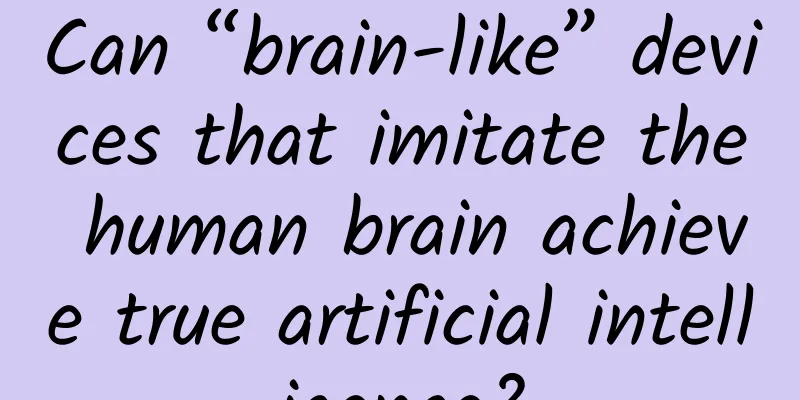Can “brain-like” devices that imitate the human brain achieve true artificial intelligence?

|
On August 24, 2023, the Science Popularization China Starry Sky Forum, with the theme of "Where is the track for general artificial intelligence?", invited 4 experts in the field of artificial intelligence research to focus on theoretical paradigms, goals, implementation methods, applications, etc., and talk about how the future general artificial intelligence technology will affect the entire human society. Professor Han Liqun , Professor of Beijing Technology and Business University and Academician of the Academy of Engineering and Technology for the Developing World, gave a speech: "Is brain-like intelligence an effective way to achieve general artificial intelligence?" 1. Seeking the "brain-like" path 1. Seeking a “brain-like” approach Now that many people are studying artificial intelligence, they naturally think of learning from the brain, asking the brain for advice, gaining inspiration, enlightenment, and reference from it. Why do so many people want to seek the path of brain-like? Because among all the known biological groups on Earth, humans are the most intelligent creatures in the world. Where is the intelligence? The intelligence lies in the human brain. Humans have the most developed brain. Copyright images in the gallery. Reprinting and using them may lead to copyright disputes. The brain is the highest product of the evolution of our material world. No biological brain has yet been discovered that can surpass it, so we say that the human brain is also the most complex information processing system in the world. Therefore, everyone, especially experts in the field of artificial intelligence, hope to find inspiration in the human brain, find something that can be learned and simulated, and use it as a prototype. Since everyone wants to find the answer from the human brain, let's first briefly talk about the human brain. If we look at it from the perspective of information processing, we can regard the human brain as a biological information processing system. What is its biological basis? In fact, the principles of biology, neurology, and anatomy clearly state that it is neurons. Neurons in the human brain are the basic units of brain tissue. They are also the functions of the nervous system. Whether in terms of structure or function, they are the smallest unit. Copyright images in the gallery. Reprinting and using them may lead to copyright disputes. How many neurons does our human brain have? It should be said that there are a huge number. In terms of order of magnitude, the number of neurons in the human brain is hundreds of billions, which is the order of 10 to 10 billion, and each neuron is connected to other neurons. A neuron has tens of thousands of connections with other neurons, which is on the order of 103 and 105. This will form an extremely large and complex biological neural network system. The connection between each neuron in the system relies on axons and dendrites. The interface between axons and dendrites is called synapse, which is the contact point between axons and dendrites. How large are synapses? Its order of magnitude is 10 to the 14th power to 10 to the 16th power, that is, one trillion to one hundred trillion. We believe that synapses change with different stimuli, so in machine learning, this part of the concept of synapses is often imitated, and it is often given another name called parameters (formerly called neurons). As you all know, ChatGPT3.0 was originally claimed to have 175 billion parameters. Compared with the neurons in the human brain, its parameters are from 100 trillion to 100 trillion, which is a small matter, so this is its biological basis. We can summarize it in one sentence. Due to the huge number of neurons, its synaptic connection mode and connection strength are different, and it has spatiotemporal plasticity, and it is constantly changing dynamically with external stimuli. From a macro perspective, the entire neural network presents an extremely complex and ever-changing information processing capability at a macro level, which is what we call intelligence, especially advanced intelligence, or cognitive intelligence. This is why we all want to find answers in the human brain and brain-like, because it has a biological basis and can naturally be imitated and inspired by artificial intelligence. 2. Brain Science’s Interpretation of the Brain To what extent has brain science understood the brain? How far has its understanding of the brain reached? There have been some breakthroughs at the micro level. As we all know, the starting point of neuroscience is neuroanatomy and histology. Its understanding and analysis of the structure of the nervous system is mainly at the molecular and cellular level. At the microscopic level, breakthroughs have been made. So what is the problem? We want to reveal the mechanism of the cognitive ability of the human brain, an extremely complex system, and what are its advanced functions and neural mechanisms? If we want to uncover the secret, it is obviously impossible to rely solely on the research results at the molecular and cellular levels. It is far from enough. Why do we say that? We know that after many molecules form nerve cells, they are no longer molecules in the original sense. Multiple nerve cells form neural circuits, which are no longer neural circuits in the original sense. Then many neural circuits form complex neural networks, and even our entire biological brain, which is no longer a neural circuit in the original sense. Therefore, we must combine the research of the microscopic level with the system level or the macroscopic level. The research on the cognitive function of the brain, that is, the advanced function, must be combined. Let's look at the level of brain science's interpretation of the brain, what kind of results have been achieved at the macroscopic level, and whether it can support our artificial intelligence research. Copyright images in the gallery. Reprinting and using them may lead to copyright disputes. If we look at the long term, the results we have achieved at the macro level over the past few decades are actually very limited. We now know the location of the language area of the brain and have a clearer understanding of it, as well as the histological segmentation of brain areas. Some people have also mapped which parts of the body the motor cortex and sensory cortex of the brain correspond to, and have drawn a map. Especially in recent years, with the development and widespread application of functional MRI imaging technology, some people who study brain science, including some people who study artificial intelligence, want to find answers from here . For example, I have read many papers in which many research teams let living organisms perform certain specific activities that they have specified, and then they observe what the blood flow signals based on electrical activity inside the brain look like, because MRI can visualize these things. We can then find out which brain areas may be involved in certain brain functions. We may have a certain understanding in this regard, but I think these results, these system-level and macro-level interpretations of the brain, are far from enough. Because so far, our understanding of brain science on how neural information produces sensations, perceptions, emotions, thinking, consciousness, language, etc., that is, these various cognitive functions of the brain, is only half-understood and very superficial. So far, we have not seen any breakthrough results in this regard. This is the reality we face when artificial intelligence wants to learn from the brain. In other words, our current level of interpretation of the brain's advanced functions by brain science is at a very low ceiling. Under this very low ceiling, how should we proceed on the road of brain-like imitation of artificial intelligence? How to carry it out? Can it be done? How to proceed? What results have been achieved? What work has been done? Copyright images in the gallery. Reprinting and using them may lead to copyright disputes. I would like to share with you that there is a lot of work in this area. People have been doing it for decades, since the 1940s. Basically, they have been looking for answers from different angles inside the brain. I think they can be roughly divided into two categories, the more popular scientific methods, one we call soft brain-like and the other hard brain-like. 3. Soft brain-like: brain-like research based on models and algorithms What is soft brain? It means that we use models and algorithms to simulate the brain. It is a soft implementation. This method and this approach actually have different specific approaches. For example, I think it can be divided into two or three approaches. One approach, I think, belongs to the bionics approach. What is it imitating? Which part of the brain-like system, the microscopic structure of the brain-like system, and the results of brain science can be utilized? We focus on imitating the structure and neural mechanism of the biological brain. We have been doing this for many years. We use experimental techniques to obtain dynamic biological data of brain tissue, and then we use information processing technology to study what kind of neural basis and information processing mechanism are contained in these data sequences. Then, based on these understandings, we give some interpretations and hypotheses of some brain models. This is what many people are doing. This kind of brain-like research and brain-like imitation research, in fact, in the history of the development of artificial intelligence, there were originally three major academic schools. The most heard one is the current deep neural network, which has gradually developed from so many models. Now it is a deep neural network, which is a brain-like model. The second way to achieve brain-likeness is to use models and algorithms. What does it imitate? It imitates the functions of the human brain, which is called the function-imitation approach. The human brain has many functions, so which part does it imitate? It imitates the logical reasoning function of the human brain, because logical reasoning is easier to formalize. If it can be formalized, it can be implemented by algorithms and programming. Whether it is a biological brain or a traditional computer architecture, in this school of thought, you are a physical symbol system. Based on the concept of physical symbol system, I use computers to simulate the functions of the brain. As for your structure, whether it is connected or not, I don’t care. I just look at your function and break away from it. It studies and develops various brain-like intelligent information systems. Early artificial intelligence adopted this approach. Copyright images in the gallery. Reprinting and using them may lead to copyright disputes. There is a school called symbolism, or functionalism, which also had many achievements in the early days and once squeezed out the previous connectionism. Where is its breakthrough now? What new achievements have been made? In fact, I think if we classify it, knowledge graphs can be counted as one of them. It used to oppose connectionism, but now it connects knowledge and becomes a knowledge graph, which is also a kind of. In the brain-like research based on models and algorithms, there is a relatively new approach in recent years, which we call the mind-mimicking approach. What does it mimic? It mimics the cognition of the human brain. What is its theoretical basis? It is based on cognitive psychology, and some achievements of cognitive psychology are used to support it, to explore the modeling of the mind. This is also a way. We have not seen any very impressive breakthrough results yet, especially the application results. We have not seen many, but this is also a way. Its cognitive architecture is to simulate the mind, the human mind, which is also a method. I think it needs modeling in the end. Although the theoretical support of modeling is different, it needs modeling, and then create a series of algorithms, and finally become a realization, so it is classified as soft brain. 4. Hard brain-like: Brain-like research based on physical realization There is another category, which is **brain-like research based on physical realization, which can be popularly called hard brain-like. Now many researchers are committed to making the operation of computers more neuromorphic. What does it mean? It means that I first pursue the similarity in form, and then consider the similarity in spirit. **This category is based on physical realization. This kind of brain-like research is also quite popular now. It should be said that there have been progresses at three levels. The three levels are artificial synapses, brain-like chips, and brain-like networks. Artificial synapses are mainly devices with some physical effects, such as memristors, synaptic transistors, etc. Let's use a device to feel it. That is, the basic unit of information processing in our human brain is called a neural synapse. What is the most unique feature of a neural synapse? It can store and calculate, so-called storage and computing integration, rather than a CPU for computing and a memory for storage. It is storage and computing integration. This is its biggest feature and the biggest advantage of the human brain in information processing mechanism compared to computers. Copyright images in the gallery. Reprinting and using them may lead to copyright disputes. The researchers found that the resistance of the memristor is related to the amount of charge, voltage and current, and the amount of charge that passes through it. When the amount of charge changes, the resistance also changes, which is equivalent to calculation, equivalent to the processing of information. Where is the memory reflected? When the power is turned off and no charge passes through, the memristor can still remember the amount of charge that passed through it before, which is memory. So its characteristics are actually very similar to the neural synapse. So it can be regarded as an electronic synapse, and it can be used to do the storage and computing integration. The other ones we just saw have similar functions. This is a level of hard brain-like, that is, making artificial synapses. The next level is brain-like chips. We know that the CPU’s energy consumption and computing efficiency have problems. How can we reduce energy consumption and improve computing efficiency? We have thought of many ways, two development routes. You may be more familiar with this, or the von Neumann architecture chip. There are three famous chips. If you are not studying electronics, you may not be familiar with this abbreviation. These are the chips. We don't care about them. There is another type of chip, which is the so-called brain-like architecture chip. We call it a brain-like chip. Now you can see that some very famous international manufacturers have launched their own products. I have seen that Zhejiang University in China has also launched a product called Darwin. These are all brain-like chips. What is the goal of brain-like chips? Its goal is to simulate the synaptic transmission structure of the human brain. It is completely brain-like. It pursues this chip architecture as close to the human brain as possible, so it is called a brain-like chip. Copyright images in the gallery. Reprinting and using them may lead to copyright disputes. What are the characteristics of brain-like chips? There are many processors in the brain-like chip architecture. These processors are equivalent to neurons. The communication system between these processors is equivalent to nerve fibers, such as axons and dendrites. Overall, the calculations of each neuron are distributed locally. This mode makes it very advantageous when processing massive amounts of data, such as our brain-like chip. We say that hard brain-like systems imitate artificial synapses from the synapses, from the chips, and then from the entire network. Of course, this is still at the conceptual level. We have not seen very good results yet. It is at the conceptual level. There may be many opinions on it in the academic community. What are some of the more typical ones we have found? People think that the architecture of the Internet has many similarities with the architecture of the human brain. Can we regard the entire Internet as a brain? This is basically based on this idea. For example, a team from the Chinese Academy of Sciences said this in their paper: The Internet is evolving in a direction that is highly similar to the human brain. The human brain has evolved all Internet functions at least tens of thousands of years ago. The ever-evolving Internet will help neuroscientists uncover the secrets of the brain. This is a very representative point of view. Copyright images in the gallery. Reprinting and using them may lead to copyright disputes. There is a neuroscientist at the University of Southern California. He said that he used the Internet routing mechanism to explain how the signal from the mouse brain bypassed the damaged area to reach the target area. He did such an experiment and then used the Internet mechanism to explain it. He came to a result. He thought he had proved that there are indeed Internet-like applications in the human brain. He did some experiments. Some professors at the University of California found that , for example, the Internet and social networks are highly similar to brain neural networks. So based on this understanding, although it is still at the conceptual level, many companies and Internet companies have begun to lay out. In 2012, 11 years ago, Google started the Google Brain project. It is the world's first In 2014, Baidu proposed the Baidu Brain, iFlytek proposed the iFlytek Super Brain, and JD proposed the JD Brain. In 2017, Alibaba and Huawei both proposed the brain or urban nervous system. In 2018, five or six major companies suddenly proposed various brains, including the City Brain proposed by the Shanghai Municipal Government. That is to say, everyone feels that the brain is so complex, with such a huge amount of data and such complex connections. They feel that the Internet is very similar to the brain, or the brain is also very similar to the Internet. This is a feeling of many people, and I think that although this concept is vague, many people have it in their hearts. At the same time, over the past decade or so, national governments, international organizations, and many well-known companies have proposed brain research plans. Moreover, these brain research plans integrate brain science projects with artificial intelligence projects. They are not purely from the perspective of brain neuroscience. They are brain-like science and brain science, which are actually two disciplines that integrate these two disciplines. There are many such brain science research plans, many of which are highly valued. However, so far, we have not seen any breakthrough results announced globally. However, these projects are underway. I think all of these are trying to create a brain, or a brain-like concept, whether from the soft or hard aspects. 5. Limitations of Brain-like Intelligence Research My own opinion is that whether the research approach of brain-like imitation has a bright future and can be continued, for those who are engaged in artificial intelligence, we must first clearly see the current limitations of the research approach of brain-like imitation. What are its limitations? Copyright images in the gallery. Reprinting and using them may lead to copyright disputes. So far, brain science has far from enough understanding of the human brain's thinking, cognition, decision-making, learning and other advanced cognitive functions. Therefore, we now know very little about the biological mechanisms of human brain intelligence, and the cognitive ceiling is very low. In this situation, how do we carry out brain-like imitation? We can only make partial breakthroughs in the manner of blind men groping in the dark, one part at a time, and then finally integrate and combine them. There may be a saying that countless relative truths combined will approach absolute truth, but I don't think that is the issue here, not such a question. Therefore, with our very limited understanding of the cognitive functions of the human brain and a very low ceiling, people from all walks of life and forces from all sides have tried their best to use various approaches to simulate the brain, whether it is imitating structure, function or anything else, whether it is implemented with model algorithms or chips, and all kinds of methods have been used. The goal is to achieve intelligence through brain-like technologies, but they all have obvious limitations. We all have a consensus, so I think it is obvious that it is not a limited way to achieve general artificial intelligence at present. Where is the track of general artificial intelligence, our theme today? I think my personal opinion on brain imitation is that when brain science cannot interpret the advanced functions of the human brain, our realization of general artificial intelligence cannot blindly pursue the technical route of brain imitation. Copyright images in the gallery. Reprinting and using them may lead to copyright disputes. What are China's top experts in the field of artificial intelligence doing now? We are not short of talent to tackle bottleneck problems. What we lack most are talents and scholars who dare to venture into uncharted territory, who can open up new tracks on their own and lead new competitions. My feeling is that in the field of artificial intelligence, especially general artificial intelligence, we need to open up a new track and have new theories and new directions. I think the theory of mechanism generation and intelligent generation mechanism can play such a role. Moreover, we are particularly lacking in such basic theoretical innovations originally created by the Chinese. Why do I think the theory of intelligent generation mechanism has the potential to open up a new era of general artificial intelligence? I found that it has two obvious characteristics: The first is that it does not involve the neural activity mechanism of the human brain , which is bypassed. We do not need to wait for brain scientists to fully understand this before we use their success to implement engineering and model it. Because it does not involve the intelligent generation mechanism, it is not affected by the lagging development of brain science. This is a feature. The second characteristic is that it is a universal law extracted from various intelligent generation processes and long-term practice. What is a universal law? It is universal. It is naturally universal, rather than integrating multiple methods into a patchwork platter, which is difficult to truly achieve universality. Planning and production Editor: Jin Yufen (Intern) |
<<: Is it true that dogs can see all the colors in Bluey?
>>: Wu Daguan: The never-ending "Chinese Heart"
Recommend
Will paying for WeChat subscription accounts change the business ecology of self-media?
On the afternoon of February 14, IT commentator H...
Why should users buy your product? 4 ways to steal competitors’ products!
Let me ask you two questions first: If there is a...
The strong alliance resulted in a half-year sales of 2700 units. The Jiyue 01 did not sell well, and the product positioning was to blame.
Naming an ordinary car as a "robot" is ...
The latest news on the Guangzhou epidemic in 2022: Is the city closed today? What is the risk level?
From 0:00 to 4:00 on April 10, 31 provinces (auton...
Eating soil is worse than eating duck blood? Are “lung-clearing” foods really useful?
Audit expert: Wang Guoyi Postdoctoral fellow in N...
How to choose event promotion channels and quickly launch events?
New media operation, channel selection, and maxim...
Kuaishou Search for Hidden Traffic Opportunities
When users' content consumption needs extend ...
When you put eye drops in, your throat becomes bitter? That's because you're not using it the right way.
This article was reviewed by Tao Ning, PhD, Assoc...
How much does it cost to apply for a 400 phone number for a company? How much does it cost to apply for a 400 phone number?
How much does it cost to apply for a corporate 40...
The battle between Uber and Shenzhou
UCAR released a set of posters today (25th), endo...
Practical review: How to operate a community and achieve revenue of over one million?
This article is based on a complete review of my ...
A complete analysis of the Toutiao search account setup and delivery ideas
As a new search platform launched this year, Tout...
Can you eat as much as you want while losing weight? Low-calorie snacks are delicious and won’t make you fat
"Would you like to eat potato chips?" -...
Do you know how dangerous it is for astronauts to go out of the spacecraft?
This article was first published by Hunzhi (WeCha...
Taking over from BAT, what are the highlights of LeTV’s parent-child hardware products?
In the era of the Internet of Things, the rapid d...









